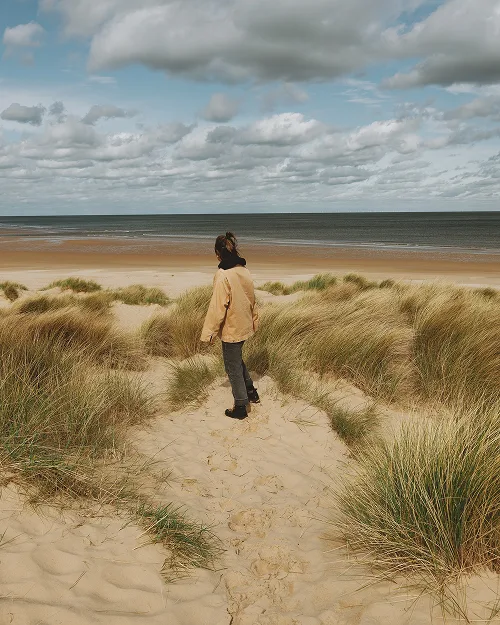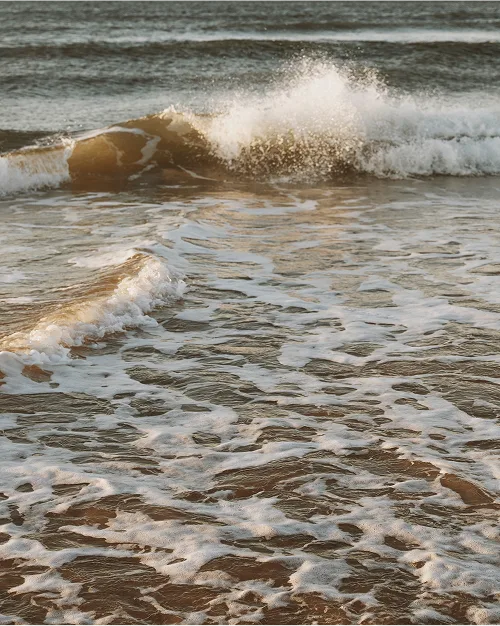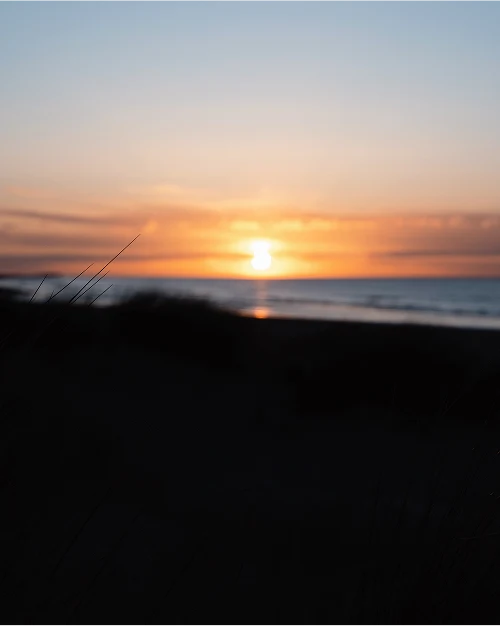
The Sky over London
Tommaso Pincio
A writer observed photographer Sølve Sundsbø at work on the Pirelli Calendar: a world that summons up vaster visions.
London. As soon as you leave the city, or travel towards it from the airport or anywhere outside of town, the most striking and captivating thing – outdoing every other aspect of a landscape that is far from bare or anonymous – is always that vast, dizzying sky: an upside-down abyss, a bottomless chasm of air and light. I wonder why it seems so much higher than the sky at home. This is the fourth day that we've been shuttling back and forth between Kensington and Uxbridge, which is over twenty kilometres from Charing Cross but still inside the M25, the huge ring road that encircles London and marks its outer boundary.

We set off every morning and come back every evening, so this is our seventh trip, and although I have a good sense of direction, I start to recognise my surroundings only when we’re almost there. Either the driver keeps changing his route, or I get distracted by the sky flowing past the window. It’s always like that, every time I come here. The English sky is mesmerising, it seems infinitely higher, even when it’s not blue but lead grey, covered by vast clouds that are just as immeasurable; clouds that sometimes hang low and heavy. Yet despite the dark colours and the low clouds that graze the housetops and horizon, this sky stretches up without end.
But really, it’s not just the sky. There’s something about the air, about the quality of light. When Michelangelo Antonioni decided to make a film out of Julio Cortázar’s short story “Las babas del diablo”, he had every good reason to change the setting from Paris to London: the plot revolves around a photographer who makes successive enlargements of some pictures he took by chance and discovers something his own eyes could never have caught. The brutal clarity that details take on here, the lush, dense colours, weave a visual magic that rarely manifests itself so intensely in any other place. London is heaven for photography.

Coincidentally – if one believes in coincidence – just around the same time that Swinging London served as a set for Blowup, it was also the birthplace of an idea that has everything to do with photography: the Pirelli Calendar. It was the company’s English branch that decided to grant new dignity to an object that had always been aimed at an all-male and not very discriminating audience, as a raunchy pleasure to be kept half-hidden in a locker, in the back of a shop, in the cab of a lorry. The goal was to turn it into something no one would be ashamed of, that could even be put on display – in other words, turn it into a piece of art. To achieve that, the real subject of the calendar had to be photography itself, the photographer, not just the women portrayed.
For the first edition, the choice landed on a friend of the Beatles, Robert Freeman, a rising star who had earned acclaim for his portraits of John Coltrane and Dizzy Gillespie. Looking back, this might all seem mundane, now that good photography is within everyone’s immediate grasp. But it wasn’t like that at the time. Thinking back – because alas, I’m now over sixty, just like the calendar – the photos that float up from the well of memory are rare, complicated objects, almost always devoid of aesthetic value. Either they emerged from the grainy black and white of a newspaper, or you’d go pick them up at the shop after waiting for days; they’d hand you an envelope and, as anxious as if it contained lab results, you would fearfully wonder: “How’d they come out?” But even when they came out fine, all you’d find yourself holding, aside from the negatives, were some clumsy pictures printed on paper in dismal, dingy colours. Maybe the progress that has come about in our ability to capture images with a camera is what best reveals the passage of time, its changes. Maybe photography itself is a calendar.
Next year’s Pirelli Calendar has been entrusted to Sølve Sundsbø, who decided to work at an outpost of technology, an advanced virtual production facility. The ultra-high-resolution screens here make it possible to create vast environments in which the backdrop – be it an interior, a futuristic city, a computer-generated world or a previously filmed landscape – wraps around the actors and the physical elements of the set. The choice of an enclosed space is pivotal to creating the worlds Sundsbø has in mind for the calendar.
The sets he has devised, in this studio flush with technological resources, are themselves enclosed spaces. Some are actual boxes, like the water-filled tank where Eva Herzigová floats in poses that make her a cross between a tailless mermaid and an unchained Houdini. Others have less visible boundaries, but one can still sense the classic geometry of an artist’s studio where everything has its place, despite the seeming chaos.
Venus Williams enveloped in fiery explosions that look like burning Rorschach blots. A mantle of sandy, almost Martian earth with the petite but athletic body of FKA twigs stretched out across it. An expanse of water with Susie Cave emerging from ripples that the light has turned as thick and warm as molten metal. Luisa Ranieri against a black background with a long white veil, blown by fans, that settles over her and swathes her like a veiled madonna.

Before locking himself away in this temple of the image, Sundsbø was up on the Norfolk coast shooting time-lapses of a sky that may be even higher than the one around London, images that later became a background of clouds for Du Juan. The open spaces of those northern beaches, where sea, sky, wind and light melt into one, reflect the man’s character, his roots. Sundsbø is Norwegian. He comes from a land where nature is prodigious and still untamed, the polar opposite of the charmingly soft curves and gentle colours that fade into the imaginary light of paintings by Leonardo and so many other Italian artists. At those high latitudes, what prevails is the awe and shock evoked by the abyss. “I sensed an infinite Scream passing through nature,” Munch wrote alongside a pastel version of what is ultimately the Mona Lisa of the Great North: a man clutching his head, his mouth wide open. Anyone who has been to Norway will understand what the painter meant, and although Sundsbø is moved by a more joyful kind of agitation, his connection to nature runs just as deep.
He’s been living in London for years now. He came here as a young man in the 1990s, when the city was experiencing one of the most intense periods in its artistic history and seemed to be Swinging once again: it was the era of Sensation, the Royal Academy show that brought the Young British Artists into the limelight, with works such as the famous shark that Damien Hirst sealed in a huge vitrine of formaldehyde. London struck Sundsbø as the perfect place to pursue photography, an interest he had discovered by watching videotapes of snow-covered slopes at the ski shop where he worked. He skied quite a bit. To him, that whiteness was a space to be filled and defined through movement, through the furrows that skis carved into the snow. Marks that were simple and unexpectedly brutal, like Lucio Fontana’s slashes, which could summon a world out of apparent nothingness. That is exactly what we’ve seen happen over the last four days: the frenetic construction – or rather, birth – of small worlds that are cut off from the city outside the studio, and from everything else. Although it doesn’t make sense to describe them as small. They’re like dreams or gardens: spaces where scale doesn’t really count, because what distinguishes them is not size but the fact that they are elsewheres, separate from all the rest. In a word, worlds.
Not coincidentally, the first space that Sundsbø dreamed up was a garden, a white room inhabited by plants of all kinds. Wandering through this sort of biosphere was Tilda Swinton, an alien creature seeking a deeper connection with the leaves and flowers. Creatures: that’s what all the women who have been invited to pose in his calendar are. Each has been asked to enter into symbiosis, become a new creature living in harmony with an element, be it air, water, fire, earth, ether, plants or light; “element” in the sense of environment, world, different forms of a single substance. Indeed, on these sets it’s often hard to tell things apart. The earth seems to be on fire, water is light, fire is liquid, the creatures’ bodies become channels connecting one elemental realm to another.

Sundsbø likes to say that scientists are the most creative people of our time. And he’s right: science creates worlds just as art does, because artists and writers – the real kind, anyway – are never satisfied with simply portraying subjects and telling stories; they open windows onto worlds that resemble ours and yet are unexpected, bewildering, unreal. Borges said that Poe created an imaginary world to escape the real one. To take it a step further, maybe he didn’t just need that world as an escape hatch, but in order to survive reality and understand it, know it better. Doesn’t the world often seem absurd and incomprehensible? Rather than simply serving as an escape, imaginary worlds help us re-establish an understanding – which has sometimes been lost, sometimes not yet found – with the real one. The world, however we see it or think we see it, must be conceived, or rather constantly reimagined, to arrive at a new harmony, a personal connection between science, art, and every great human undertaking; among our many forms of knowledge, which are increasingly partitioned, specialised, distant from each other or even in conflict.
Outside the car, the sky keeps flowing past and I wonder why it seems so much higher than the one back home. It must be a northern mirage. In the desert you think you see an oasis; here it’s a sky higher than anywhere else. For that matter, there’s something ludicrous about the very idea of a sky being higher. How far up is the sky still sky? As far as the atmosphere goes? As far as it’s still blue? Then for a moment I think I’ve had an epiphany. It’s the clouds. The swirling speed with which they move here expands the sky, turns it into a rugged expanse where chasms can open up and suck everything in. Turner’s paintings suddenly flash before me, the ones in which little or nothing can be made out because everything is composed of a single, gleaming element, a perennially spinning sky. I think of John Constable and his studies of clouds. That is the secret of this sky: the clouds that Sundsbø shot in time-lapse in Norfolk. How beautiful the world is, when it reveals itself.
Story
"In the age of social media, photography has become the brick with which each of us constructs our identity. And since everyone wishes to portray themselves as a little better than they perceive themselves to be, it has also become a brick of artifice."READ THE INTERVIEW